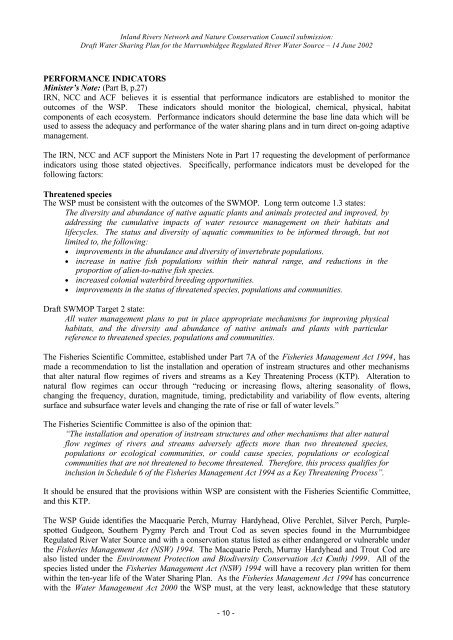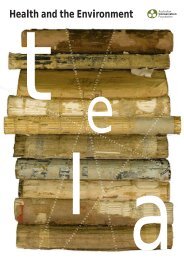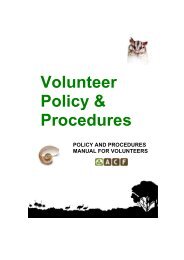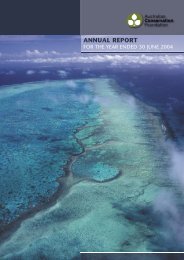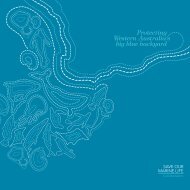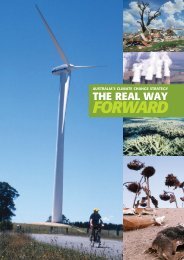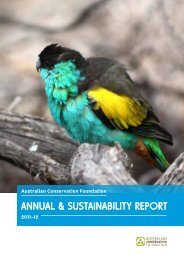Submission on Draft Water Sharing Plan for the Murrumbidgee River
Submission on Draft Water Sharing Plan for the Murrumbidgee River
Submission on Draft Water Sharing Plan for the Murrumbidgee River
Create successful ePaper yourself
Turn your PDF publications into a flip-book with our unique Google optimized e-Paper software.
Inland <strong>River</strong>s Network and Nature C<strong>on</strong>servati<strong>on</strong> Council submissi<strong>on</strong>:<br />
<strong>Draft</strong> <strong>Water</strong> <strong>Sharing</strong> <strong>Plan</strong> <strong>for</strong> <strong>the</strong> <strong>Murrumbidgee</strong> Regulated <strong>River</strong> <strong>Water</strong> Source – 14 June 2002<br />
PERFORMANCE INDICATORS<br />
Minister’s Note: (Part B, p.27)<br />
IRN, NCC and ACF believes it is essential that per<strong>for</strong>mance indicators are established to m<strong>on</strong>itor <strong>the</strong><br />
outcomes of <strong>the</strong> WSP. These indicators should m<strong>on</strong>itor <strong>the</strong> biological, chemical, physical, habitat<br />
comp<strong>on</strong>ents of each ecosystem. Per<strong>for</strong>mance indicators should determine <strong>the</strong> base line data which will be<br />
used to assess <strong>the</strong> adequacy and per<strong>for</strong>mance of <strong>the</strong> water sharing plans and in turn direct <strong>on</strong>-going adaptive<br />
management.<br />
The IRN, NCC and ACF support <strong>the</strong> Ministers Note in Part 17 requesting <strong>the</strong> development of per<strong>for</strong>mance<br />
indicators using those stated objectives. Specifically, per<strong>for</strong>mance indicators must be developed <strong>for</strong> <strong>the</strong><br />
following factors:<br />
Threatened species<br />
The WSP must be c<strong>on</strong>sistent with <strong>the</strong> outcomes of <strong>the</strong> SWMOP. L<strong>on</strong>g term outcome 1.3 states:<br />
The diversity and abundance of native aquatic plants and animals protected and improved, by<br />
addressing <strong>the</strong> cumulative impacts of water resource management <strong>on</strong> <strong>the</strong>ir habitats and<br />
lifecycles. The status and diversity of aquatic communities to be in<strong>for</strong>med through, but not<br />
limited to, <strong>the</strong> following:<br />
• improvements in <strong>the</strong> abundance and diversity of invertebrate populati<strong>on</strong>s.<br />
• increase in native fish populati<strong>on</strong>s within <strong>the</strong>ir natural range, and reducti<strong>on</strong>s in <strong>the</strong><br />
proporti<strong>on</strong> of alien-to-native fish species.<br />
• increased col<strong>on</strong>ial waterbird breeding opportunities.<br />
• improvements in <strong>the</strong> status of threatened species, populati<strong>on</strong>s and communities.<br />
<strong>Draft</strong> SWMOP Target 2 state:<br />
All water management plans to put in place appropriate mechanisms <strong>for</strong> improving physical<br />
habitats, and <strong>the</strong> diversity and abundance of native animals and plants with particular<br />
reference to threatened species, populati<strong>on</strong>s and communities.<br />
The Fisheries Scientific Committee, established under Part 7A of <strong>the</strong> Fisheries Management Act 1994, has<br />
made a recommendati<strong>on</strong> to list <strong>the</strong> installati<strong>on</strong> and operati<strong>on</strong> of instream structures and o<strong>the</strong>r mechanisms<br />
that alter natural flow regimes of rivers and streams as a Key Threatening Process (KTP). Alterati<strong>on</strong> to<br />
natural flow regimes can occur through “reducing or increasing flows, altering seas<strong>on</strong>ality of flows,<br />
changing <strong>the</strong> frequency, durati<strong>on</strong>, magnitude, timing, predictability and variability of flow events, altering<br />
surface and subsurface water levels and changing <strong>the</strong> rate of rise or fall of water levels.”<br />
The Fisheries Scientific Committee is also of <strong>the</strong> opini<strong>on</strong> that:<br />
“The installati<strong>on</strong> and operati<strong>on</strong> of instream structures and o<strong>the</strong>r mechanisms that alter natural<br />
flow regimes of rivers and streams adversely affects more than two threatened species,<br />
populati<strong>on</strong>s or ecological communities, or could cause species, populati<strong>on</strong>s or ecological<br />
communities that are not threatened to become threatened. There<strong>for</strong>e, this process qualifies <strong>for</strong><br />
inclusi<strong>on</strong> in Schedule 6 of <strong>the</strong> Fisheries Management Act 1994 as a Key Threatening Process”.<br />
It should be ensured that <strong>the</strong> provisi<strong>on</strong>s within WSP are c<strong>on</strong>sistent with <strong>the</strong> Fisheries Scientific Committee,<br />
and this KTP.<br />
The WSP Guide identifies <strong>the</strong> Macquarie Perch, Murray Hardyhead, Olive Perchlet, Silver Perch, Purplespotted<br />
Gudge<strong>on</strong>, Sou<strong>the</strong>rn Pygmy Perch and Trout Cod as seven species found in <strong>the</strong> <strong>Murrumbidgee</strong><br />
Regulated <strong>River</strong> <strong>Water</strong> Source and with a c<strong>on</strong>servati<strong>on</strong> status listed as ei<strong>the</strong>r endangered or vulnerable under<br />
<strong>the</strong> Fisheries Management Act (NSW) 1994. The Macquarie Perch, Murray Hardyhead and Trout Cod are<br />
also listed under <strong>the</strong> Envir<strong>on</strong>ment Protecti<strong>on</strong> and Biodiversity C<strong>on</strong>servati<strong>on</strong> Act (Cmth) 1999. All of <strong>the</strong><br />
species listed under <strong>the</strong> Fisheries Management Act (NSW) 1994 will have a recovery plan written <strong>for</strong> <strong>the</strong>m<br />
within <strong>the</strong> ten-year life of <strong>the</strong> <strong>Water</strong> <strong>Sharing</strong> <strong>Plan</strong>. As <strong>the</strong> Fisheries Management Act 1994 has c<strong>on</strong>currence<br />
with <strong>the</strong> <strong>Water</strong> Management Act 2000 <strong>the</strong> WSP must, at <strong>the</strong> very least, acknowledge that <strong>the</strong>se statutory<br />
- 10 -


